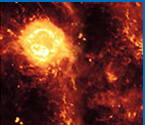We welcome more comments.
Email us your comments.
Proposed Cancellation of the James Webb Space Telescope: a Major Attack on a Foundational Science Program For the Next Generation
The move by the House Appropriations Committee to cancel the James Webb Space Telescope (JWST), the planned successor to the Hubble Space Telescope, represents a major attack on a foundational science program for the next generation – an attack on science itself. Though occurring in the context of major budgetary battles in the government, any claim that this is somehow needed for budgetary constraint, would be laughable if this were not so serious. To take just one example, the government spends over $20 billion dollars annually for air conditioning the military in Iraq and Afghanistan.
The proposed cut to NASA's budget would save only $1.6 billion. The total cost of the Webb Space Telescope is $6.5 billion, much of it already spent. Over ¾ of the components of the project are built and under test. Recall that the Hubble Space Telescope, which revolutionized our view of the universe, ran over budget and schedule during development. JWST has encountered similar issues but is still slated for launch in 2018.
The JWST provides humanity with the chance to answer some of the biggest questions we have about the universe. It has four mission science goals: Search for the first galaxies or luminous objects that formed after the Big Bang. Determine how galaxies evolved from their formation until the present. Observe the formation of stars from the first stages to the formation of planetary systems. Measure the physical and chemical properties of planetary systems and investigate the potential for life in those systems.
Astronomy Community Speaking Out
Many astronomers and groups are speaking out in defense of this critical project. Some examples: The American Astronomical Association issued a statement which said (in part):
“The JWST is the highest-ranked mission in the National Academy of Science’s Astronomy and Astrophysics decadal survey released in 2000 and remains a high priority for the Nation’s astronomers in this decade as well, as the revolutionary successor to the Hubble Space Telescope. This survey, conducted once every 10 years by hundreds of the Nation’s leading scientists, prioritizes — based on scientific merit and impact — projects proposed by the scientific community that require significant government support for completion. These reports represent a community consensus on the efforts necessary to advance our knowledge of the universe.”
Two Informative - and Entertaining! - Videos About the James Webb Space Telescope
(this 2nd video may not work on some versions of IE - use Firefox or Safari instead)
Dr. William S. Smith, President of the Association of Universities for Research in Astronomy said
“Against a backdrop of widespread discussion over the future of NASA and the human spaceflight program, it is tragic that the Congress is also proposing to curtail NASA’s science program. JWST is NASA’s premier science facility, unsurpassed by any other telescope now or in the future.”
Speaking of the importance of the JWST in a blog posted at Cosmic Variance, an astronomy instructor noted:
“First and foremost, in many fields of astronomy we are rapidly approaching the limit of what can be done scientifically without JWST. I recently finished teaching a graduate class on extragalactic astronomy, and I can’t tell you the number of times where I brought the students up to speed on the state of a field, and then had to say “If we’re going to push this to the next level, we need JWST”.” … Canceling JWST is not going to usher in a golden age of other space-based science opportunities (the “crowding out theory”, where once the shade of JWST is gone, a thousand flowers will bloom). The money will simply be gone from space-based astronomy, and instead of a single tree we can all climb, there will be some smaller pieces of shrubbery.”
Blog from the Editors of Scientific American: Threat of James Webb Space Telescope Cancellation Rattles Astronomy Community
As NASA prepares to wrap up its shuttle program, leaving open questions about what comes next for U.S. human spaceflight, the next big thing in NASA's astronomy program has been dealt a blow. The James Webb Space Telescope, a tennis court–size spacecraft that would take up a position in deep space to peer farther than ever into the cosmos, has been in development as a replacement for and successor to the Hubble Space Telescope, which has already logged 21 years in orbit. But the House Appropriations Committee, in a bill announced July 6, proposed axing the project entirely this week, citing mismanagement and bad budgeting.
The bill, which would cut $1.6 billion, or about 9 percent, from NASA's overall budget, would have to clear the full House and gain Senate approval before becoming law. But the specter of JWST cancellation looms large over a field already facing diminished resources. "Obviously, this proposal...is upsetting," American Astronomical Society (AAS) Executive Officer Kevin Marvel wrote on his organization's blog. "The astronomy community knows the value of the JWST, recognizes that nearly all technical hurdles have been overcome and that a review of the program's management, budget and completion plan is nearly complete."
The House committee's concerns have some grounds; in November 2010, a review convened by Sen. Barbara Mikulski (D–Md.) found JWST was well behind schedule and $1.4 billion over budget, bringing the total estimate for the observatory to $6.5 billion. (NASA has already spent roughly half that amount.) The telescope, which had been targeted for a 2014 launch, would launch no sooner than 2015, the report concluded. In recent months much later launch dates of 2018 or beyond have been rumored.
But delays and cost overruns are nothing new for projects of unprecedented scale. Take the launch of the Hubble Space Telescope, which is a much smaller observatory than JWST, orbiting far closer to Earth, and whose deployment was a much simpler affair than the elaborate de-cocooning JWST will have to perform in deep space. Hubble was famously delayed by seven years, from a 1983 launch to a 1990 launch, and had just about tripled in cost by the time it reached orbit, according to a 1992 U.S. General Accounting Office (now the Government Accountability Office) report (pdf). By the time of that GAO report, the Hubble's price tag was roughly $3 billion in 2011 dollars. Its cost over the years has swelled to several times that amount, thanks to two decades of operations and five space shuttle visits to the telescope for servicing. (A single shuttle servicing mission costs about $2 billion, according to one NASA estimate.)
Who knows if Congress would have given a greenlight to Hubble if its total cost were known from the start? But few would argue now that the orbiting observatory has been a poor investment. In fact it has revolutionized humankind's view of the universe.
And who knows what would have happened if Congress had not canceled the Superconducting Super Collider (SSC)? The SSC, a mammoth particle physics experiment in Texas, was axed in 1993 when its price tag grew too large for Congressional funders' liking. Roughly $2 billion had already been sunk into the project by 1993, but its estimated cost had doubled from $5.3 billion to more than $11 billion. (That is about $17 billion in 2011 dollars.)
The SSC would have been the successor to the much less powerful Tevatron in Illinois, a workhorse particle collider that is scheduled to be shut down this year. Instead the title of most powerful collider moved to Europe, when the Large Hadron Collider (LHC) came online in late 2009 and quickly eclipsed the Tevatron by colliding particles at higher energies than had ever been achieved. But whereas the LHC is designed to be about seven times as powerful as the Tevatron, the SSC would have been 20 times as powerful as the Tevatron and nearly three times as powerful as the LHC.
Email this article to a friend.





